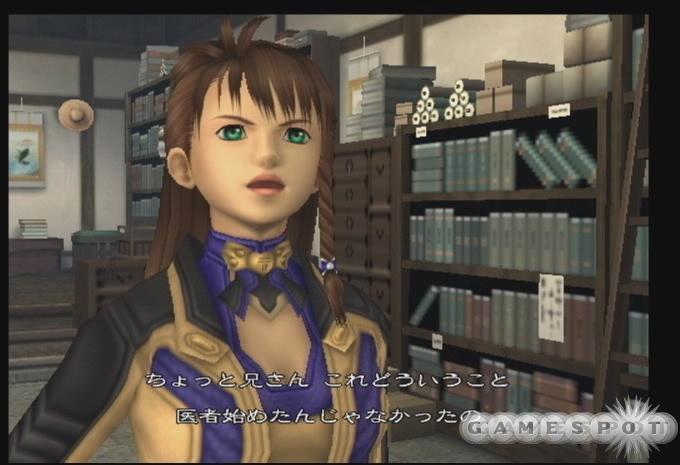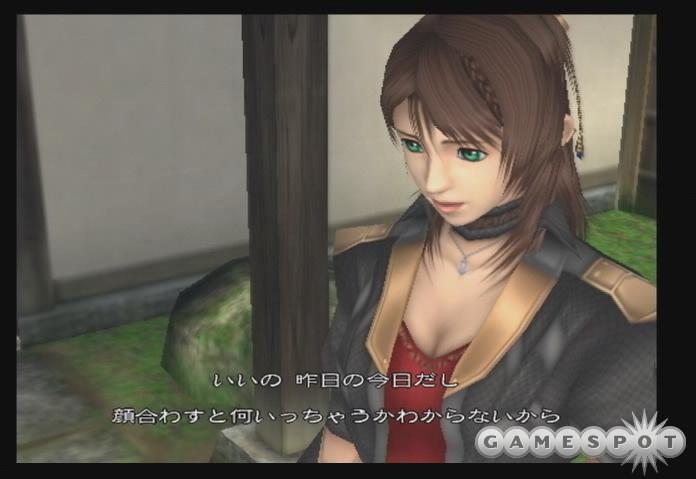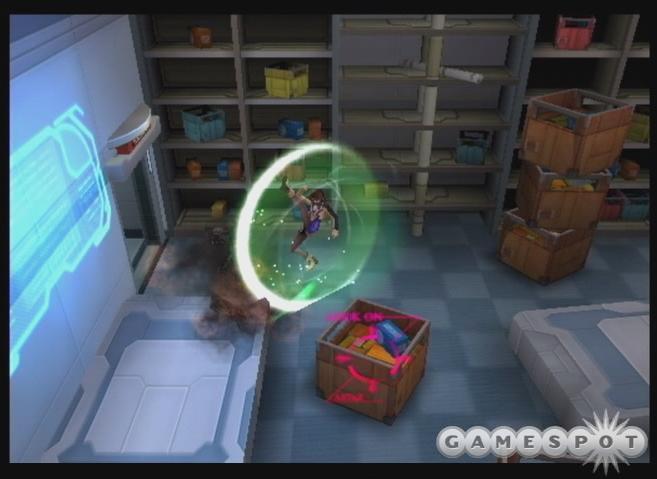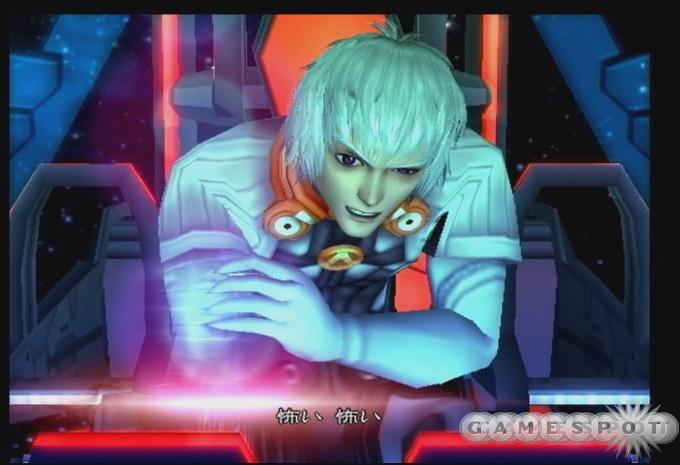Xenosaga Episode II: Jenseits von Gut und Bose Import Hands-On Impressions
We snagged the recently released Japanese version of Namco's sci-fi RPG sequel and are here with some impressions.
Xenosaga Episode II: Jenseits von Gut und Bose is the second entry in Namco's sci-fi role-playing game trilogy on the PlayStation 2. We got our hands on the just-released Japanese import of the game to find out just what happens in this new entry in the series. If you want to see for yourself, take a look at some brand-new footage of the game in action.

Episode II starts out with a flashback scene taking place 14 years prior to the first game, where the synthetic humans called realians have suddenly gone out of control. In this sequence, you control Chaos--who should be a familiar character from Episode I--and a new character named Canaan, who's a special realian that's immune to things that affect normal realians. During your short jaunt through this flashback, in which you're on a top secret mission for the government, you meet up with a samurai named Jin Uzuki, who's the big brother of Episode I main character Shion Uzuki.
With the appearance of Jin, you find out about a document called the Y-data, which holds the key to uncovering what's going on with the realians, as well as the identity of the person or persons who are behind it all. While your party goes on to find the Y-data, your mission gets cut short by the appearance of Margulis, who Episode I fans will remember as an unbeatable boss. Things are a bit different now, thankfully, since you can actually defeat him this time around. In any event, Chaos and Canaan return home with only a fraction of the Y-data, which Jin uploads to Canaan's memory (he disposes of the hard copy). But before they safely make their way to home base, Canaan gets assaulted by an unknown black cloud that damages the data that he's just received.
The game's scene then switches to the planet of Second Miltia, 14 years later, which is where refugees from the original Miltia escaped after their land became uninhabitable. After a short cutscene in which Canaan is seen being examined due to yet another data blackout, the scene changes to the familiar characters from Episode I and their cargo ship. Arriving on Second Miltia directly after their intense adventures in Episode I, the party splits up into two groups, since the blue-haired android Kos-Mos needs to go through an equipment change in Vector Corporation's lab, and the girlish realian Momo needs to have her own Y-data deciphered at the U.M.N. center. However, things on Second Miltia are not as safe as they may seem, and Momo once again almost gets kidnapped by henchmen who have been sent by Margulis. Further on in the storyline, we learned that Margulis is planning to excavate the original Zohar--an ancient artifact with mysterious powers--from the first Miltia. The Zohar is also known to have some connection to the deadly, unidentified alien life-forms called the gnosis, which have been one of the key elements in Xenosaga's storyline.
Similar to Xenosaga Episode I, Episode II is extremely story-driven, with multiple plot threads occurring concurrently and even more characters appearing in the scenarios this time around. You'll be watching noninteractive 3D cutscenes for hours during the game, but the well-developed battle system and various side games help to make up for the short span of actual gameplay time. One change that helps to give you more freedom is that Episode II features a walk-able map from the early stages of the game, which in Episode I wasn't available until later on at the Kukai Foundation.

The most noticeable change in the graphics in Xenosaga Episode II is the styling of the characters, which no longer have their animelike look. The characters all have a more grown-up look to them, which may seem a bit unnatural at first because of the sudden change but shouldn't be too difficult to get used to after some time with the game. Some of the characters have gone though additional cosmetic changes, most notably the female characters such as Shion, with her new costume, and Momo, who now fights with a bow and arrow. To accommodate the taller and more-mature look of the characters, it seems that the field maps have also become roomier in comparison to Episode I. Some areas of the Kukai Foundation and its city are definitely larger than they were portrayed in the first game, for instance.
The field system in Xenosaga Episode II plays identically to that in Episode I. You walk from area to area, solving puzzles if necessary and destroying objects to uncover new paths and hidden items. You'll transition into battle when you encounter enemies that are visible on the screen, but these can often be weakened beforehand by blasting trap objects that are usually found close to their locations. The enemies in Episode II seem to have an easier time catching you than in the first game, and it doesn't seem to be as easy to evade them by simply maneuvering around them. Fortunately, two of the party members--Shion and Momo--come equipped with the escape command by default. So if you want to skip the fighting and go on to the next movie, you can escape from a battle and use an invincibility ability on the field screen afterward to run away from the enemy. You can get experience points even if you escape from a battle as long as you've defeated at least one enemy, which gives you a good reason to make a tactical retreat if you think you're in a dangerous situation.
The battle system in Xenosaga Episode II inherits a number of points from Episode I, such as the boost or the event slot, but there are a few new changes and additions that have greatly modified the gameplay. The basic method of attacking is with the square, triangle, and circle buttons, which, in Episode II, correspond to the height of your attack. Enemies in the game have weak points based on their height, which are called zones. If you hit an enemy's zones in the right sequence, you can put it into a "break" condition, which causes it to take 50 percent additional damage from your attacks. For example, a normal soldier may be weak against a combination of a middle and low attack, while a tall robot may be weak against two high hits.

One of the new additions to the battle system is the adoption of a stock system, where your party character rests for one turn in order to store up extra power (which can be accumulated up to three times). There are two ways that the stock system can be used. One is to inflict additional attacks on an enemy in a single turn. If you execute another attack directly after you've put the enemy into break condition, you can knock the enemy into the air or grind it into the ground, where it will take even more damage than usual. If you use the boost system that the game inherited from Episode I, which lets you bring in a designated party member to act during the upcoming turn, you can inflict still more damage while the enemy is still in this condition.
Another way of using stocks is in team-up attacks, which are powerful moves that can only be done once per battle under limited conditions. In order to execute a team-up attack, two members that have a corresponding skill need to have a certain number of stocks (this number depends on the attack you're trying to execute). When your two characters have the required number of stocks, you need to boost the off character during the active character's turn. If you then open up the battle menu with the X button, you'll see that there's a "double" command available to execute the team-up attack. Episode II also has a similar ether magic system, which lets you execute a powerful team-up move that allows you to heal or restore the status of all your party members at once. The team-up ether can be executed when one of two characters with the required ether boosts the other, in which case no stocks are required.
There are some other points worth mentioning about the battle system. For instance, a few things have been cut out from the battle system in Episode I, such as the AP system and the AP special attacks. Also, while the game still has its A.G.W.S. robot battle (now referred to as E.S. robot battle), it seems to be dependent on the scenario in Episode II, and there's no option in the battle menu to pilot your robot whenever you want to.
While not a part of the battle system, some interesting things that were taken out of the game are shops and a money system, meaning that the only way you can get items and equipment is from defeating enemies, breaking objects, and completing events. This places greater importance on ether magic, which has no weight limit this time as it did in Episode I. This time around, the more ether you learn, the higher-level ether you can acquire.

Xenosaga Episode II also has a whole new system dedicated to mini-events, called the G2 Campaign. Once you sign up as a member of the G2 Campaign early in the game, you can take on different assignments to help people who are troubled for one reason or another, such as a laundromat owner who's having rat problems. The game rewards success with bonus items such as decoders to unlock segment doors and swimsuits for your characters, but you'll need to be careful, since you can actually fail these mini-event missions.
Based on what we've played so far, we suspect that if you enjoyed watching and playing Xenosaga: Episode I, chances are that you'll enjoy Episode II as well. Just like its predecessor, however, this is a very story-driven game, so even if you're a hardcore fan of the series and you want to get firsthand experience with the game, you'll need a pretty firm grasp on the Japanese language to get the most out of the import. Xenosaga Episode II: Jenseits von Gut und Bose is slated for release in the US in February of next year. If you're stuck waiting until then, check out a slew of new movies on the game's media page.
Got a news tip or want to contact us directly? Email news@gamespot.com
Join the conversation